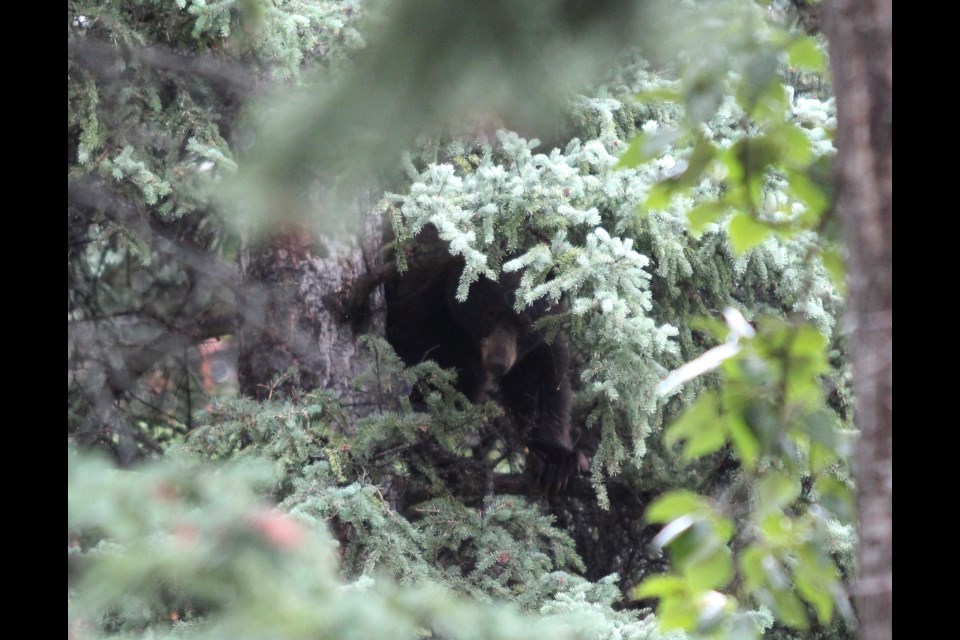CANMORE – A habituated black bear relocated from a busy tourist area in Canmore may be the same one that was hanging around a gas station in search of garbage and involved in an incident with dogs.
Fish and Wildlife officers darted the treed bear, a sub-adult female showing signs of habituation, around 1 p.m. on Saturday (Aug. 31) near Kananaskis Way and Bow Valley Trail. It had been hanging around the busy residential and commercial area for the previous five days.
Jay Honeyman, a human-wildlife conflict specialist for Alberta Environment and Parks, said the bear was moved for public safety reasons.
“Earlier in the week, we had a bear and a few dogs over by the dog park near the helipad that had a bit of a confrontation. They were on the other side of the fence and were just kind of yacking at each other,” he said.
“There’s been a bit of activity behind the Fas Gas and kind of walking around the garbage there, though the garbage can is bear-proof. It’s difficult to say for sure it’s the same bear, but there’s a good chance it was.”
On Saturday morning, Fish and Wildlife received calls about a bear on Kananaskis Way feeding on berries and dogwood by the side of the road.
Jason van Rassel, a spokesperson for Alberta Justice and Solicitor General, said the bear climbed up a tree to try to avoid capture.
“The Fish and Wildlife officer determined it was an unsafe location to try to immobilize the bear, because a balcony fence and jagged boulders below the tree which could have injured the bruin if it fell out of the tree,” he said in an email.
At about 12:30 p.m., the bear climbed out of the tree and ran down the street from 190 Kananaskis Way towards Bow Valley Trail before steering into a wooded area and pathway in front of Solara Resort and Spa.
Fish and Wildlife officers, RCMP members and Canmore Bylaw peace officers followed the bear. It was treed, darted.
“Officers were then able to tree the bear in a more suitable location," said van Rassel.
“This time, a Fish and Wildlife officer successfully immobilized the bear as Canmore bylaw officers, an RCMP officer and a conservation officer contained the area.”
Honeyman said the bear was feeding on natural dogwood bushes throughout the week, noting there are also many ornamental fruit trees in the area ripe with berries.
“The point is there’s a lot to hold a bear there and we need to make these areas less appealing to bears,” he said.
“At the end of the day, we’re not in a position to be allowing that bear to stay there and do that kind of thing for days on end. It’s a public safety concern.”
Because of the high density nature of developments in that area of town, there are concerns that bears could become aggressive if they feel trapped or cornered trying to get away.
“There’s a lot of nooks and crannies in those places and it’s pretty high density, so when we do get a bear in there it’s a little tricky and we don’t have a lot of choices,” he said.
“Through no fault of the bear, it will need to respond because it’s in an area where they can’t really get out of easily and people, through not fault of their own, are going to maybe be in the way – and that’s part of the liability concern that we have.”
According to the Bow Valley human-wildlife coexistence taskforce, there is consensus among wildlife managers that wildlife needs to be discouraged from using developed areas.
Much of the focus in Canmore has been around trying to remove or secure unnatural food and natural attractants within developed areas.
“We’re really trying to discourage wildlife from being in town because once they’re in town and habituated, particularly on non-natural foods, we really don’t have a lot of options,” said Honeyman.
“We need to figure out how to keep them out of town, and that means stop feeding them intentionally or not, particularly on non-natural foods,” said Honeyman, who sat on the taskforce.
“Some of these bears get quite used to being in and around developments if they’re finding food successfully. There’s not a lot of negative consequences when they’re in town until the local officers come by and by then it’s too late.”
Last month, Canmore council unanimously agreed to increase the fine for residents who don’t remove fruit from their trees or have bird feeders on their property during the seasonal ban from $100 to $250 as part of a larger wildlife attractant management plan.
The amended bylaw specifically targets three types of fruit trees, including but not limited to, crabapple trees, mountain ash trees and shepherdia bushes, also known as a buffaloberry bush.
Honeyman welcomed news.
“I think it’s a good attempt to keep working on the issue, and we’ll have to wait and see,” he said.
On July 31, a black bear was relocated from the Palliser residential area in Canmore after being struck by a vehicle on the nearby Trans-Canada Highway.
On May 2, a black bear that reportedly got into garbage left out in the Peaks of Grassi neighbourhood was killed by wildlife officers.
The male bear, which was relocated about 40 kilometres away in August 2018 after getting into garbage in the same neighbourhood, was killed by Fish and Wildlife officers after returning to the area where it got a food reward.
In the most up to date figures available, the province has destroyed 20 black bears and one grizzly bear in the Bow Valley. The grizzly, a four-year-old male known as number 99, was the one that killed a local woman in June 2005 as she jogged near Silvertip.
In addition, 66 black bears and 12 grizzly bears have been moved out of the Bow Valley over the same time frame.
– With files from Jordan Small




